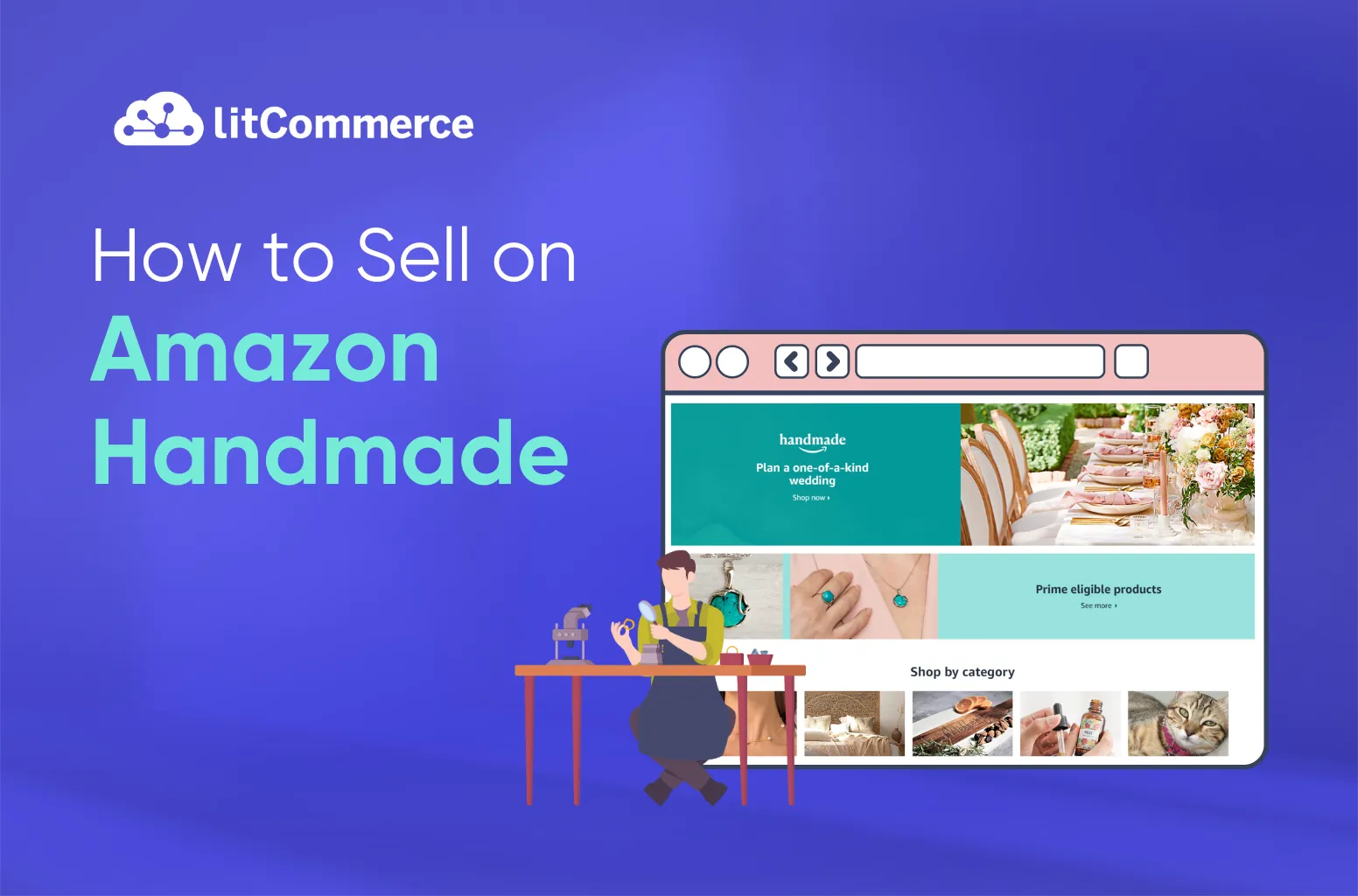If you are about to sell handcrafted items online, you may have heard of Amazon Handmade. But what exactly is it? Is selling on Amazon worth it for artists and crafters? Most importantly, how can you sell on Amazon Handmade? Let me help you easily answer those questions.
You may need to spend time on the application and wait for approval to sell on Amazon Handmade. This step might hinder some sellers from selling on Amazon, but don’t worry—I am here to help you easily register as an Amazon Handmade Seller.
Let’s check this guide to learn:
- Amazon Handmade overview
- How to sell on Amazon Handmade
- Amazon Handmade selling tips and tricks
Wait no more and dive right in to have an Amazon Handmade Seller account in hand now!
Amazon Handmade Overview
If you wonder how to sell handmade items on Amazon, you should learn about Amazon Handmade. For more insightful information, check the details below.
What is Amazon Handmade?
Amazon Handmade is a special place on Amazon where artists and crafters can sell their unique creations to people everywhere. Here, only handmade, hand-altered, or hand-assembled items are allowed—no mass-produced stuff. The selling accounts here are different from regular Amazon accounts, with their own rules and ways of doing things.
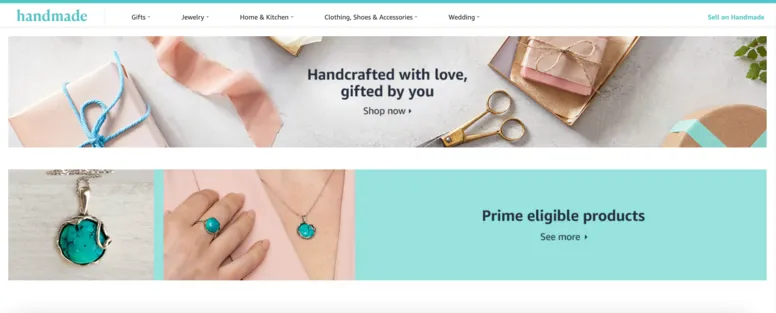
Why should sell on Amazon Handmade?
There are several reasons why Amazon Handmade has become a go-to-pace for artisans, including:
- Amazon draws over 2 billion monthly visitors, with 90% of U.S. consumers shopping there. If you’re selling online, Amazon is where you want to be.
- According to Jungle Scout’s 2022 report, a third of Handmade sellers enjoy profit margins of over 20%.
- Amazon Handmade charges no listing fees, only a 15% fee per sale, much lower than standard Amazon seller fees.
- Amazon Handmade is strictly for artisans. It ensures that only handmade goods make the cut, giving shoppers a more unique experience.
- Sellers can create custom shop and artisan profiles to showcase their products and share their stories, offering personalized items.
- Listings don’t expire, and UPCs aren’t required to sell on Amazon Handmade.
How does Amazon Handmade work?
Amazon Handmade operates differently from a standard seller account on Amazon. Here’s a breakdown of how it works:
- You and your team create the products.
- You apply to sell on Amazon Handmade. You must fill out an application form, which might take around 30 minutes.
- Wait for their approval, and then you can start listing your first item on Amazon. Handmade and done!
To be more detailed about each step, let’s move on to the next part, where I will share with you specific steps you need to take.
How to Sell on Amazon Handmade – Our Guide Only for Beginners
If you already have handmade items to sell on Amazon Handmade, you can skip straight to step 2 to set up your account. If you’re looking for Amazon product ideas, check out my blog post about the best products to sell on Amazon.
Step 1. Choose products to sell on Amazon Handmade
If you want to learn how to sell handmade items on Amazon, you must first find the right ones to sell. Trust me, this step is really important because there are now tons of sellers joining Amazon Handmade, making it hard to stand out. Looking for products to sell may require some time, but here are some effective strategies you can consider.
1.1. Conduct searches on Amazon and Etsy
One easy and free way to research products to sell is by using the search feature on Amazon or another marketplace for handmade like Etsy. Using this way can give you deeper insight into market trends and customer preferences.
Let’s start by looking at the search results for each handmade category; you can discover the current top-selling products. Handmade also grants a “Best Seller” badge to top-selling products, similar to the rest of Amazon. Based on these searches, you’ll know which handmade items are popular and successful.
For example: if you search for “handmade necklace” and filter by “Bestseller,” you’ll notice that many top-selling products often offer products with customization options or are made with gemstones. Personally, I think it would be a great idea if you could offer items that include both of these features.
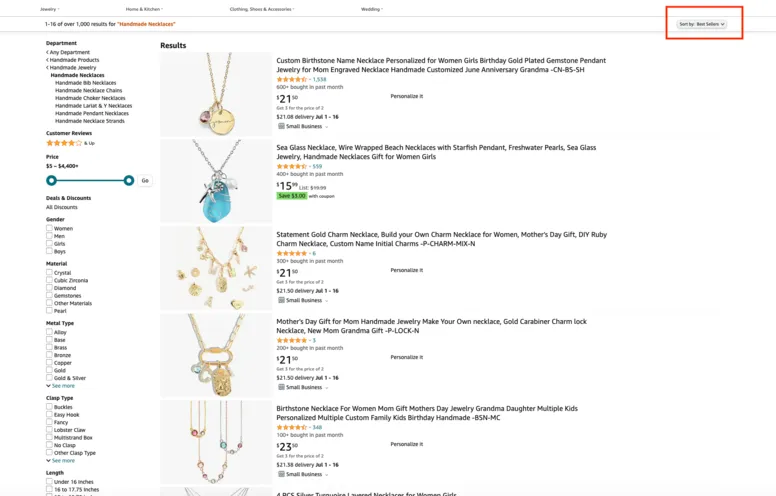
Beside you can look into Amazon Mover and Shakers to learn which products gain most sales in 24 hours. This list is updated frequently, which give you a deeper insight into which items are currently on demand.
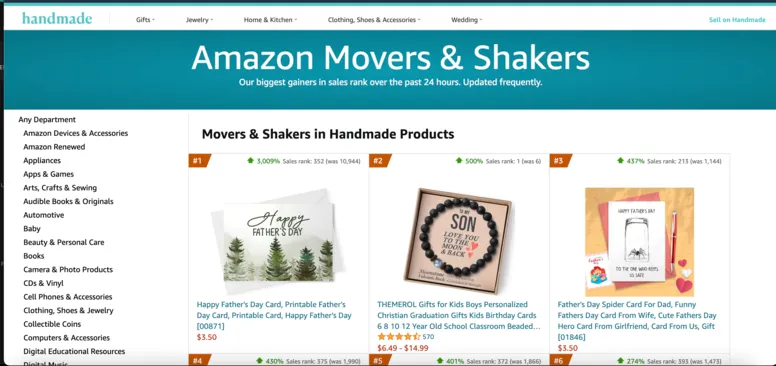
You can also look at the number of reviews to determine if a product sells quickly or not. Usually, only 2 out of every 100 buyers leave a review. So, if you see many reviews for a product, it’s probably been selling well.
Another way you can check a product’s sale performance is by examining its review section on the listing and applying the “Most recent” filter. This will show you how frequently someone has bought the product recently. If the most recent review is from two years ago, the product is likely not selling as much anymore.
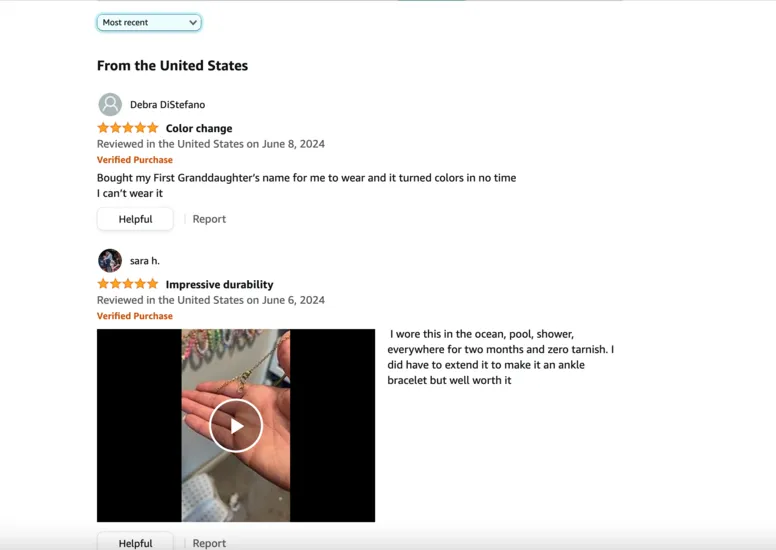
1.2. Use paid tools for further research
If the methods mentioned above only provide general ideas of what to sell on Amazon Handmade, you can consider paid tools with enhanced features to gain deeper insights. These tools can offer a more detailed understanding of market dynamics, competitor analysis, consumer trends, and product demand, such as Jungle Scout or AMZScout.
AMZScout offers a feature called Product Scores and Niche Scores. Product Scores evaluate the sellability of an individual product, while Niche Scores assess the sellability of a niche. These features can give sellers a clear understanding of market potential and help them make informed decisions about what to sell.
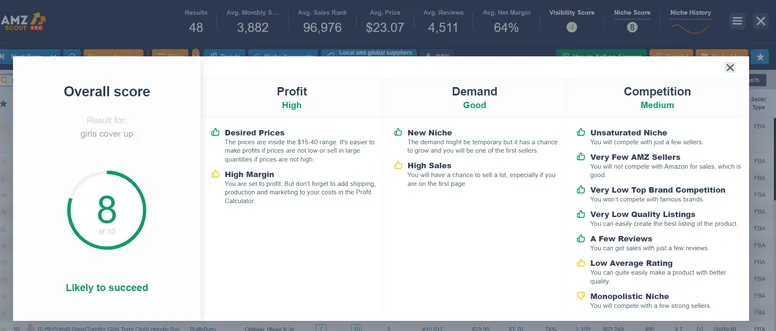
Meanwhile, Jungle Scout is also a great choice. They offer a Product Database, a searchable catalog that lets you choose categories and set specific filters to find well-selling products. Additionally, you can use their Opportunity Finder, a tool designed to help you discover new, unique niches and capitalize on emerging trends.
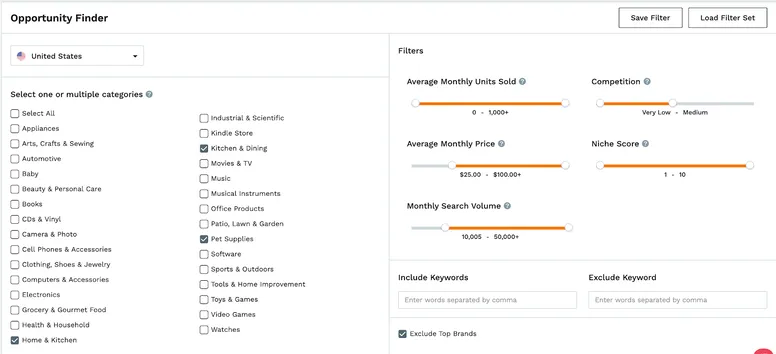
After trying both Jungle Scout and AMZScout, here’s my advice:
- If you need highly accurate data and larger data, Jungle Scout is the right tool for you.
- If you prefer a more affordable option with plenty of educational materials, AMZScout is a better fit.
1.3. Verify demand for existing products you create
If you already have your own product and want to check if it’s profitable to sell, I have some helpful tips to share with you.
# Search in Google Trends
You can use Google Trends to perform a keyword search for the product you have already created to observe current trends. Examine the past 12 months and the last 5 years to determine if the product’s popularity has increased over time.
For instance, if you craft handmade candles, enter “handmade candles” into Google Trends. Look at the interest over time, noting any peaks or steady increases in searches. This analysis will help you gauge if there is a rising demand for your product.
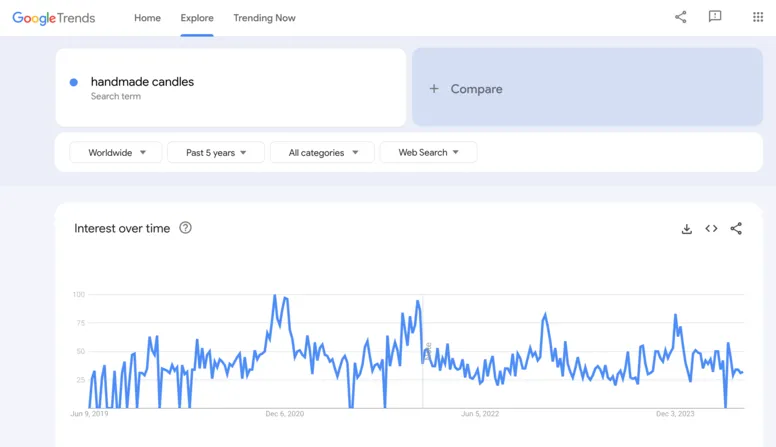
# Search on Amazon Handmade and Etsy
Personally, I think the most helpful and simple way to check the demand for the product you are currently making is by searching for it on Amazon Handmade and Etsy. If you find similar products being sold with reviews, it’s a positive sign of demand for that product.
You can consider these ways to differentiate your handmade products from those currently available:
- Provide more unique customizations
- Create your goods with higher-quality materials
Step 2. Set up an Amazon seller account
To sell on Amazon Handmade, you must create an Amazon account. However, you can’t sell handmade items on Amazon as an individual seller. Instead, you need to sign up for a Professional Seller account, which costs $39.99 per month.
Once you become an Amazon Handmade seller and get approved, the fee is waived. So, you typically only need to pay it once. Additionally, Amazon will refund the fee for the first month.

Step 3. Apply to become an Amazon Handmade Seller
Once you’ve become a professional seller, you can apply to sell on Amazon Handmade. This is the most important step in how to sell on Amazon Handmade.
According to Amazon, Handmade refers to products that are:
- Handcrafted: Made completely by hand.
- Hand-altered: Existing products transformed into new designs, like adding hand-painted artwork to a plain t-shirt.
- Handmade customized: If you customize a handmade product, such as engraving personalized messages on wooden signs as per the customer’s request, you can sell it on Amazon Handmade.
Note: Mass-produced items might not receive approval, like a coffee mug added with a monogram. Additionally, I don’t suggest you list items manufactured in China and then label them as handmade. This can result in removal from the sellers’ list if Amazon discovers them.
To apply for Amazon Handmade, visit the Amazon Handmade page and click on the yellow button labeled “Apply Now.” Then, you will go through a set of questions. This guide on how to sell handmade products on Amazon will help you fill in the information correctly.
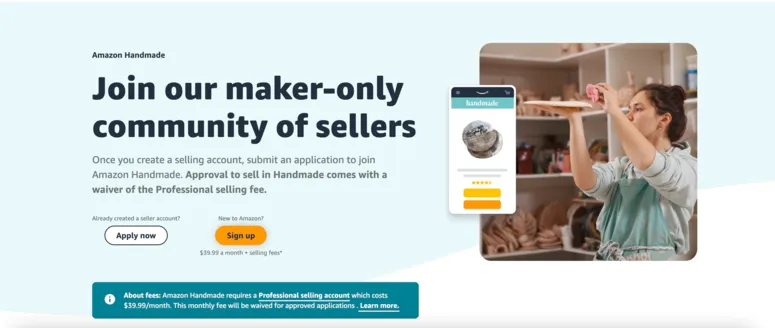
First, Amazon will need your information about yourself and your business.
In this step, you need to fill in your basic information and ensure it is the same as your Amazon Professional account.
3.1. Select which type of customer you are
- Maker working alone: You are working independently without any employees or collaborators.
- Maker with less than 20 employees: You have a small team of fewer than 20 employees who assist you in the production process.
- Collaborative group of makers: This could be cooperatives, nonprofits, and charities that support local makers
- Other: This option is for sellers who don’t fit into any of the above categories.
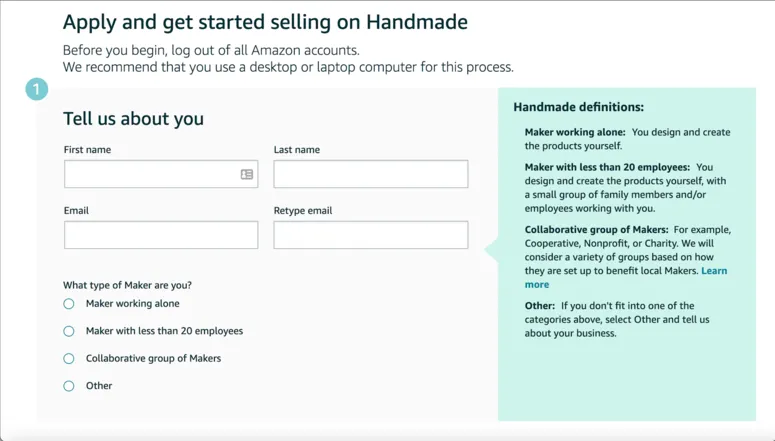
The next part, “Tell us about your work,” provides an opportunity for you to describe your products and the process by which you create them.
3.2. Choose the option that best represents your work
- My products are handcrafted (if you personally create each product from scratch)
- My products are hand-altered (if you modify existing products to create something new)
- I don’t make my own products; I customize each one based on the buyer’s request (if you customize products based on requests)
- I purchase handmade products from Makers and sell them
3.3. Select the option that accurately describes your production process
- I design and make my own products
- I design and make my products, but a small portion of the work is done by an outside company or group
- I design my products and send them out for production
- I do not design or produce my products
3.4. What portion of your production process is completed by you or your employees?
- 75-100% (if you join in most or all aspects of the production process)
- 50-74% (if you join in more than half of the production process)
- 25-49% (if you join in less than half of the production process)
- 1-24% (if you have minimal involvement in the production process)
- None (if you join in any aspect of the production process)
Note: Your choices must be consistent. For example:
If you’re a solo artisan handling all aspects of production, I think you should choose the option respectively when applying to sell on Amazon Handmade:
- Maker working alone
- I design and make my own products
- 75-100%
This consistency helps provide a clear and accurate representation of your business to Amazon Handmade, facilitating the review process and increasing the likelihood of approval.
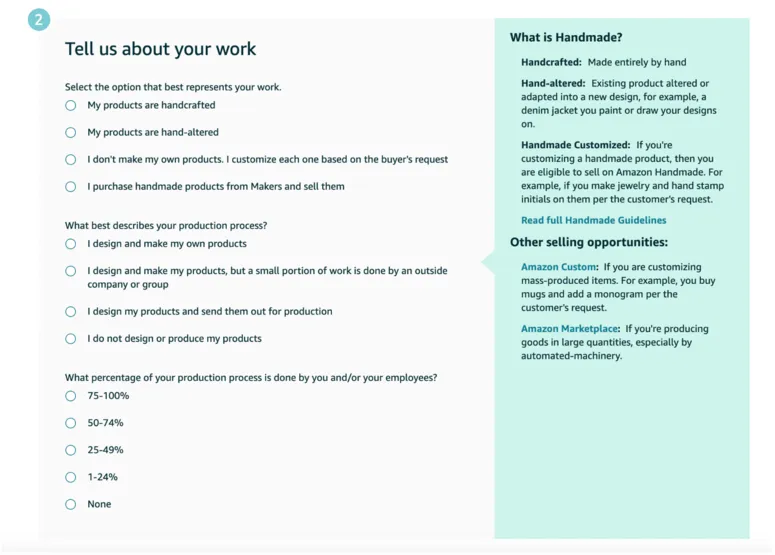
3.5. Tell us about your products and processes
At this step, you need to give Amazon a thorough description of how you make a product to sell on Amazon Handmade. To ensure your products meet Amazon Handmade criteria, provide:
- Detailed descriptions of your materials;
- Production processes (techniques or tools used);
- Timeframes for each step.
Due to space limitations, it is recommended that you draft this information in a Word editor before copying it into the provided textbox.

3.6. Show us your work
While the “Show us your work” section is labeled optional, I highly advise you to complete it as part of your application process. Amazon suggests providing photos of either your finished products or your production process. You should show Amazon as much detail as possible to avoid any delays in the approval process.

3.7. Select your product category
To complete your application, select the most suitable category for your products from the options provided on Amazon Handmade:
- Accessories
- Artwork
- Baby
- Beauty & Personal Care
- Clothing, Shoes & Handbags
- Home, Outdoor & Home Care
- Jewelry & Watches
- Kitchen & Dining
- Pet Supplies
- Sporting Goods
- Stationery & Party Supplies
- Toys & Games
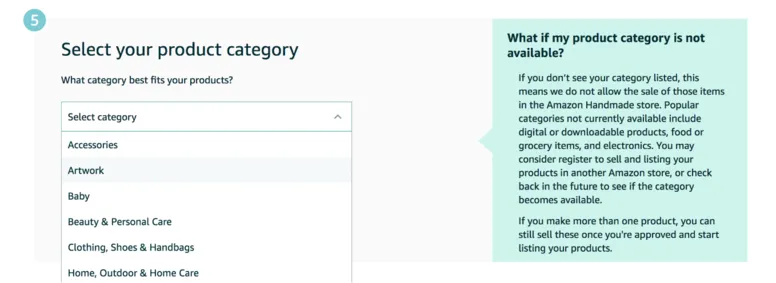
Note: If your desired category, such as food or electronics, is not listed, Amazon Handmade is currently not accepting products from these categories. You may need to explore other avenues or marketplaces to sell products in these categories.
3.8. Final section
In this part, Amazon Handmade asks how sellers discovered the marketplace. This part is optional and can be skipped.
Finally, review the application again and check the box to confirm compliance with Amazon Handmade. Then, click the “Submit Application” button to complete the process. After submission, wait for the Amazon Handmade Team to assess your application and provide a response within 7-14 days.

Step 4. List your Amazon handmade items
Once your Amazon Handmade store is set up and ready, it’s time to list your very first products.
The process for listing products on Amazon Handmade is the same as creating a listing for a regular Amazon product:
- Go to Seller Central > Inventory > Add a Product.
- Select “Create a New Product Listing.“
- Choose the Handmade category.
Fill in product details, including titles, descriptions, and images. Ensure completeness in your listings, as Amazon favors complete product information for search visibility.
Step 5. Utilize various programs and expand your business
With millions of sellers on the platform competing for customers, you’ll need to promote your handmade products to succeed. Luckily, Amazon has various programs to support new sellers, such as Amazon Vine Program, Fulfillment by Amazon or Amazon Ads. Besides how to sell handmade products on Amazon, let me show you more about these programs that can help you succeed on your business journey.
1. Amazon Vine Program

The Amazon Vine program is an invitation-only program where Amazon provides products to trusted reviewers in exchange for their unbiased opinions.
New sellers may find it hard and time-consuming to get reviews for their products, which can build trust among buyers. So, if you want your listing to have reviews displayed to increase the chance of customer purchases, you can join this program. Ensure you offer top-quality products to receive the best reviews for your products.
If you want more helpful tips to receive positive reviews from buyer, read this guide on how to get Amazon reviews.
2. Fulfillment by Amazon (FBA)

It’s a service offered by Amazon. Sellers send their products to Amazon’s fulfillment centers, and Amazon takes care of the storage, packing, and shipping of those products to customers. This program is perfect if your products are in high demand.
However, when joining this program, you will pay extra fees, such as fulfillment or storage fees.
3. Amazon Ads

Last but not least, Amazon Ads is the most powerful tool to drive customers to your listings. It is a suite of advertising tools on Amazon that enables sellers to create targeted pay-per-click (PPC) advertising campaigns to promote their products. While this tool offers the flexibility of placing on-site and off-site ads, it does need an investment. Therefore, you should learn about Amazon scams to avoid them when selling.
Note: Even if you have an Amazon Handmade account, Amazon may require additional business details. To avoid any account suspension, I suggest you pre-prepare the proof of ownership of your products. You can document the process of making any products as evidence.
3 Amazon Handmade Selling Tips and Tricks
The above information will get you started on the platform, but in order to give yourself an edge, you need to be utilizing the best strategies. If you want to learn how to sell on Amazon Handmade successfully, consider the tips below to help you outdo your competitors:
1. Write creative descriptions
Handmade products can be a bit different from other products sold on Amazon because they can hold the story of their makers. Plus, customers value the backstory behind handmade items, making it essential to put this into your product description.
Here is an example from Elaine Coyne Collectible Artwear Store of how you can include your story in products description. You can consider using Amazon A+ Content like this to effectively convey your behind-the-scenes story and message.
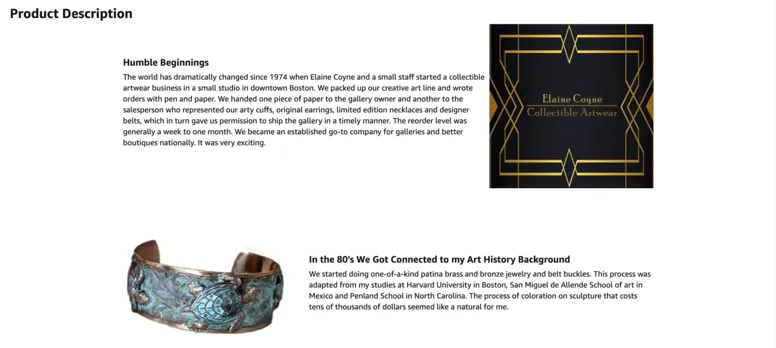
As you see, sharing the inspiration behind your creation and how you brought it to life in your descriptions can greatly enhance the appeal of your product and connect with buyers on a deeper level.
2. Use concise keywords
Adding the right keywords to your product title and description can significantly influence your sales when selling handmade items on Amazon. It’s all about Amazon SEO, which you can learn about in this Amazon SEO guide. You can also incorporate your keywords into your PPC campaigns to target the right customers and convert more sales.
3. Use high-quality images and videos
When people shop online, customers rely on images to imagine what an item looks like. If your pictures are unclear or fail to showcase all the product features, potential buyers may hesitate to make a purchase. Hence, ensure your images are of high quality and provide multiple angles to display all aspects of your product.
Also, for the best result, I suggest including a video demonstrating the careful crafting process of your products or showcasing how they can be used. Doing this can assist buyers in their purchase decisions.
How to Sell on Amazon Handmade: FAQs
When deciding whether to sell on Amazon Handmade or Etsy, keep in mind that you have the option to use both platforms! However, if you’re trying to determine which is more suitable for you, consider these main points: + 3% + $0.25 payment processing fee There are two main fees to consider for Amazon Handmade sellers: Remember: Listing products on Amazon Handmade is free. Approval for Amazon Handmade can be more selective than for other platforms like Etsy. While it can be selective, it’s not necessarily impossible. Here are some things to consider:
Feature
Etsy
Amazon Handmade
Artisan Approval
Less strict
More strict application needed
Fees
$0.20 Listing fees + 6.5% transaction fee
Only 15% referral fee
Categories
Broader (vintage, craft supplies)
Strictly handmade products
Start Selling Handmade Items on Amazon Today!
Is it worth selling on Amazon Handmade? Absolutely! As a relatively new platform, it offers a huge opportunity for you to list your unique, handmade products and stand out. So, let’s take advantage of this chance to start a successful business and reach a vast audience eager for handcrafted items by learning how to sell on Amazon Handmade with this complete handbook.
If you want more help guides sharing tips to sell on any marketplace and eCommerce platforms, check out our Blog now. You can also contact us if you need support promptly from LitCommerce.

